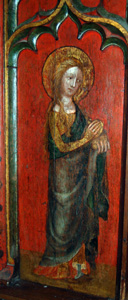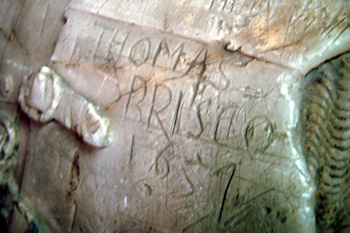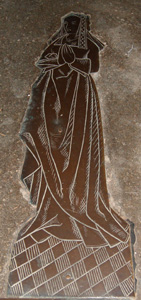
Clifton church March 2007
All Saints church dates largely to the early 14th century. However, a church existed here in 1202 (the date of the first known rector) and common sense indicates that there must have been a church of some description here from well before the Norman Conquest of 1066.

Looking north-west from the nave to the north aisle November 2009
The church is built of coursed rubble, mostly ironstone, with some ashlar facings. The building comprises a nave and chancel of the early 14th century, both in the Decorated style. The south porch belongs to the same century as does the west tower, though it was rebuilt about a century later. The north aisle is Perpendicular in design and belongs to the 15th century. The vestry is late 19th century.

Clifton font, showing the 15th century screen behind November 2009
Moving inside, the font, if it is original to the church, is the oldest thing about the building. It is made of Purbeck stone and is 13th century, though the pedestal on which it stands is 19th century. Most of the interior is pure 1850s restoration except for the building's two late medieval gems.

Mary Magdalene from the 15th century screen November 2009
The first of these gems is a screen of the 15th century. It described by Sir Nikolaus Pevsner in his Buildings of England volume on Bedfordshire as "Not good" as it was then not restored. It was treated in 1992 and now reveals splendid the paintings of Old Testament prophets paired with New Testament saints on a rick red background. It does not now stand as a rood screen between the nave and chancel but behind the font at the west end of the church leading to the base of the tower.

The tomb of Sir Thomas Lucy and his wife November 2009
The other late medieval gem is the tomb of Sir Thomas Lucy, (once thought to be that of Sir Michael Fisher) in the north chapel, now used as a vestry. It is 16th century (he died in 1525). The monument is of alabaster and was clearly once very fine, though it has now been battered as well as defaced by many graffiti, some as early as the 17th century.

A graffito of 1657 on Sir Thomas Lucy's tomb November 2009
A brass in the floor next to the monument is to John Fisher. He was the son of Michael, to whom the alabaster monument was once thought to belong. There is also a brass of Fisher's wife and they date to 1528.

Brass of Sir Michael Fisher's wife November 2009
A glebe terrier of 1822 [P7/1/8], before the church's restoration, describes it as: "an ancient building containing in length Sixty five feet and an half, in breadth Thirty eight feet and an half, the Chancel in breadth sixteen feet. On the north side of the Chancel is a Chapel in breadth Seventeen feet. The Steeple is fifteen feet by fourteen square within the walls, in height fifty Nine feet". The north chapel, which had belonged to Clifton Manor was pulled down, then rebuilt and enlarged between 1862 and 1863.